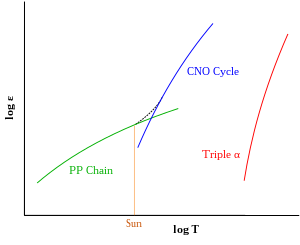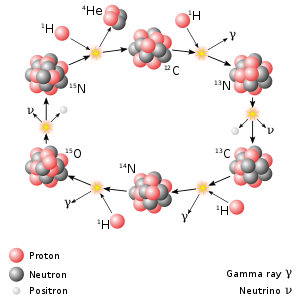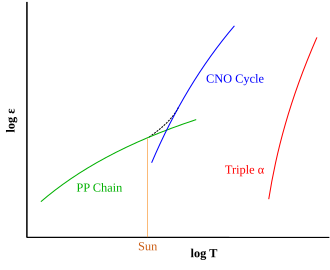
A fusion energy gain factor, usually expressed with the symbol Q, is the ratio of fusion power produced in a nuclear fusion reactor to the power required to maintain the plasma in steady state. The condition of Q = 1, when the power being released by the fusion reactions is equal to the required heating power, is referred to as breakeven, or in some sources, scientific breakeven.
The energy given off by the fusion reactions may be captured within the fuel, leading to self-heating. Most fusion reactions release at least some of their energy in a form that cannot be captured within the plasma, so a system at Q = 1 will cool without external heating. With typical fuels, self-heating in fusion reactors is not expected to match the external sources until at least Q = 5. If Q increases past this point, increasing self-heating eventually removes the need for external heating. At this point the reaction becomes self-sustaining, a condition called ignition. Ignition corresponds to infinite Q, and is generally regarded as highly desirable for practical reactor designs.
Over time, several related terms have entered the fusion lexicon. Energy that is not captured within the fuel can be captured externally to produce electricity. That electricity can be used to heat the plasma to operational temperatures. A system that is self-powered in this way is referred to as running at engineering breakeven. Operating above engineering breakeven, a machine would produce more electricity than it uses and could sell that excess. One that sells enough electricity to cover its operating costs is sometimes known as economic breakeven. Additionally, fusion fuels, especially tritium, are very expensive, so many experiments run on various test gasses like hydrogen or deuterium. A reactor running on these fuels that reaches the conditions for breakeven if tritium was introduced is said to be operating at extrapolated breakeven.
As of 2021, the record for Q is held by the JET tokamak in the UK, at Q = (16 MW)/(24 MW) ≈ 0.67, first attained in 1997. The highest record for extrapolated breakeven was posted by the JT-60 device, with Qext = 1.25, slightly besting JET's earlier 1.14. ITER was originally designed to reach ignition, but is currently designed to reach Q = 10, producing 500 MW of fusion power from 50 MW of injected thermal power.
In the case of neutrons carrying most of the practical energy, as is the case in the D-T fuel, this neutron energy is normally captured in a "blanket" of lithium that produces more tritium that is used to fuel the reactor. Due to various exothermic and endothermic reactions, the blanket may have a power gain factor MR. MR is typically on the order of 1.1 to 1.3, meaning it produces a small amount of energy as well. The net result, the total amount of energy released to the environment and thus available for energy production, is referred to as PR, the net power output of the reactor.
The blanket is then cooled and the cooling fluid used in a heat exchanger driving conventional steam turbines and generators. That electricity is then fed back into the heating system. Each of these steps in the generation chain has an efficiency to consider. In the case of the plasma heating systems,  is on the order of 60 to 70%, while modern generator systems based on the Rankine cycle have
is on the order of 60 to 70%, while modern generator systems based on the Rankine cycle have  around 35 to 40%. Combining these we get a net efficiency of the power conversion loop as a whole,
around 35 to 40%. Combining these we get a net efficiency of the power conversion loop as a whole,  , of around 0.20 to 0.25. That is, about 20 to 25% of
, of around 0.20 to 0.25. That is, about 20 to 25% of  can be recirculated.
can be recirculated.
Thus, the fusion energy gain factor required to reach engineering breakeven is defined as:

To understand how  is used, consider a reactor operating at 20 MW and Q = 2. Q = 2 at 20 MW implies that Pheat is 10 MW. Of that original 20 MW about 20% is alphas, so assuming complete capture, 4 MW of Pheat is self-supplied. We need a total of 10 MW of heating and get 4 of that through alphas, so we need another 6 MW of power. Of the original 20 MW of output, 4 MW are left in the fuel, so we have 16 MW of net output. Using MR of 1.15 for the blanket, we get PR about 18.4 MW. Assuming a good
is used, consider a reactor operating at 20 MW and Q = 2. Q = 2 at 20 MW implies that Pheat is 10 MW. Of that original 20 MW about 20% is alphas, so assuming complete capture, 4 MW of Pheat is self-supplied. We need a total of 10 MW of heating and get 4 of that through alphas, so we need another 6 MW of power. Of the original 20 MW of output, 4 MW are left in the fuel, so we have 16 MW of net output. Using MR of 1.15 for the blanket, we get PR about 18.4 MW. Assuming a good  of 0.25, that requires 24 MW PR, so a reactor at Q = 2 cannot reach engineering breakeven. At Q = 4 one needs 5 MW of heating, 4 of which come from the fusion, leaving 1 MW of external power required, which can easily be generated by the 18.4 MW net output. Thus for this theoretical design the QE is between 2 and 4.
of 0.25, that requires 24 MW PR, so a reactor at Q = 2 cannot reach engineering breakeven. At Q = 4 one needs 5 MW of heating, 4 of which come from the fusion, leaving 1 MW of external power required, which can easily be generated by the 18.4 MW net output. Thus for this theoretical design the QE is between 2 and 4.
Considering real-world losses and efficiencies, Q values between 5 and 8 are typically listed for magnetic confinement devices, while inertial devices have dramatically lower values for  and thus require much higher QE values, on the order of 50 to 100.[11]
and thus require much higher QE values, on the order of 50 to 100.[11]
Ignition[edit]
As the temperature of the plasma increases, the rate of fusion reactions grows rapidly, and with it, the rate of self-heating. In contrast, non-capturable energy losses like x-rays do not grow at the same rate. Thus, in overall terms, the self-heating process becomes more efficient as the temperature increases, and less energy is needed from external sources to keep it hot.
Eventually Pheat reaches zero, that is, all of the energy needed to keep the plasma at the operational temperature is being supplied by self-heating, and the amount of external energy that needs to be added drops to zero. This point is known as ignition. In the case of D-T fuel, where only 20% of the energy is released as alphas that give rise to self-heating, this cannot occur until the plasma is releasing at least five times the power needed to keep it at its working temperature.
Ignition, by definition, corresponds to an infinite Q, but it does not mean that frecirc drops to zero as the other power sinks in the system, like the magnets and cooling systems, still need to be powered. Generally, however, these are much smaller than the energy in the heaters, and require a much smaller frecirc. More importantly, this number is more likely to be near-constant, meaning that further improvements in plasma performance will result in more energy that can be directly used for commercial generation, as opposed to recirculation.
https://en.wikipedia.org/wiki/Fusion_energy_gain_factor



















